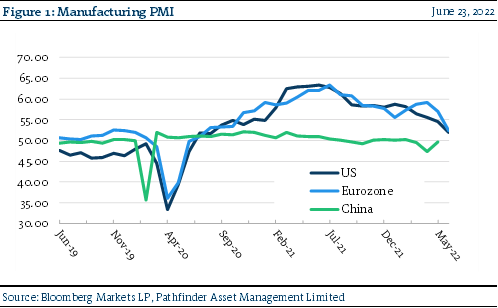Purchasing Managers Indices and Recession
This past week, data from European and North American countries were released that showed deteriorating expectations from managers in developed markets. There are several different data points that show manager intent and expectations put out by different providers. They are all useful but because they are produced independently by different companies and for specific countries, the construction and survey methodology are different and therefore not 100% comparable. One data series that we like is called the Global Purchasing Managers’ Index (PMI) series, put out by IHS Markit, a British company that “provides independent data, trade processing of derivatives, foreign exchange and loans, customized technology platforms” across multiple countries.
The PMI consists of several different surveys of managers from businesses in manufacturing or services. IHS asks questions of 400 companies (in each country) for 20 segments of their businesses and managers mark 1 for improvement, 0.5 for no change and 0 for deterioration. The survey is done every month for each country. The data is compiled together and a score above 50 indicates expected improvement over the coming months, while a score below 50 indicates contraction.
- Figure 1 presents PMI data for manufacturing companies from the three major world economies. As you can see, after a period of strength, the data have dropped the past year (recently more quickly in the US and Europe).
- Service companies, on the other hand, have posted better results but we thought it was interesting, in the context of recession expectations, that manufacturing expectations are slowing.
- Note that, other than China, the data shows that manufacturing is still expected to expand; however, that rate of growth has decreased. It will be interesting to see if the data series drop into contraction over the coming months.

“This means that” various data points have recently caused the investment community to become somewhat focused on the potential for recession. In our opinion, the drop in equities markets so far this year was mostly valuation related, i.e.. stocks dropped because of a perceived change in interest rate expectations due to central bank attempts to reign in inflation. The concern developing now is more related to a potential decrease in earnings due to a slow down in the global economy. We view this as a natural part of the investment cycle and a developing opportunity to get our portfolios positioned in some of the best companies in the world.
National Instrument 31-103 requires registered firms to disclose information that a reasonable investor would expect to know, including any material conflicts with the firm or its representatives. Doug Johnson and/or Pathfinder Asset Management Limited are an insider of companies periodically mentioned in this report. Please visit www.paml.ca for full disclosures.
*All returns are time weighted and net of investment management fees. Returns from the Pathfinder Partners’ Fund and Partners’ Real Return Plus Fund are presented based on the masters series of each fund. The Pathfinder Core: Equity Portfolio and The Pathfinder Core: High Income Portfolio are live accounts. These are actual accounts owned by the Pathfinder Chairman (Equity) and client (High Income) which contain no legacy positions, cash flows or other Pathfinder investment mandates or products. Monthly inception dates for each fund and portfolio are as follows: Pathfinder Core: Equity Portfolio (January 2011), Pathfinder Core: High Income Portfolio (October 2012) Partners’ Fund (April 2011), Partners’ Real Return Plus Fund (April, 2013), and Partners’ Core Plus Fund (November 2014).
Pathfinder Asset Management Limited (PAML) and its affiliates may collectively beneficially own in excess of 10% of one or more classes of the issued and outstanding equity securities mentioned in this newsletter. This publication is intended only to convey information. It is not to be construed as an investment guide or as an offer or solicitation of an offer to buy or sell any of the securities mentioned in it. The author has taken all usual and reasonable precautions to determine that the information contained in this publication has been obtained from sources believed to be reliable and that the procedures used to summarize and analyze such information are based on approved practices and principles in the investment industry. However, the market forces underlying investment value are subject to sudden and dramatic changes and data availability varies from one moment to the next. Consequently, neither the author nor PAML can make any warranty as to the accuracy or completeness of information, analysis or views contained in this publication or their usefulness or suitability in any particular circumstance. You should not undertake any investment or portfolio assessment or other transaction on the basis of this publication, but should first consult your portfolio manager, who can assess all relevant particulars of any proposed investment or transaction. PAML and the author accept no liability of any kind whatsoever or any damages or losses incurred by you as a result of reliance upon or use of this publication.